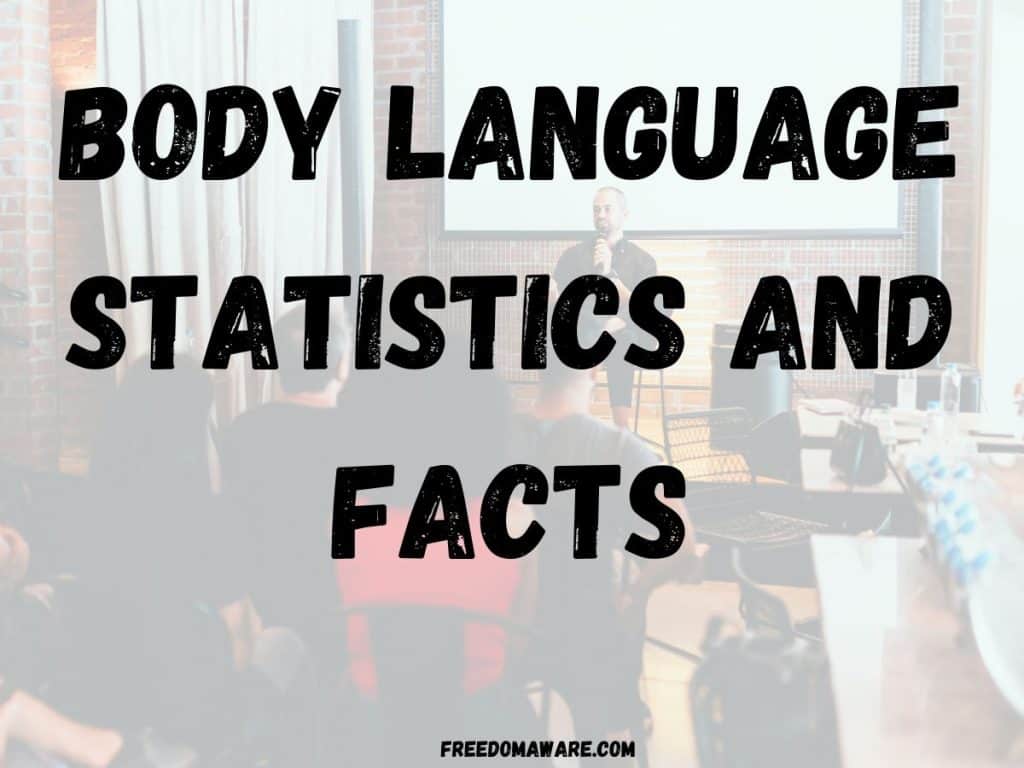30+ Important Body Language Statistics and Facts (2024)

Communication is a vital aspect of our lives, influencing how we connect and convey our thoughts and feelings to others. While words carry meaning, they alone are not enough to fully express our intentions and emotions.
A significant portion of communication happens through nonverbal cues, such as facial expressions, gestures, and body language. Understanding and mastering these cues can greatly enhance our communication skills and foster better connections with those around us.
In this article, we delve into the world of body language and present a comprehensive collection of crucial statistics and facts.
These insights highlight the significance of nonverbal communication, providing valuable guidance for anyone seeking to sharpen their ability to interpret and employ body language effectively.
Table of Contents
Effective communication is a cornerstone of success in personal and professional realms. While verbal communication is crucial, the impact of body language should not be underestimated.
Non-verbal communication, expressed through body language, is the silent language we use to convey thoughts and feelings without uttering words. Micro-expressions and subtle gestures often unveil our true sentiments rather than the façade we might want others to perceive.
Surprisingly, more than 70% of communication is non-verbal, underscoring the significance of comprehending body language for effective communication and attentive listening.
To navigate the intricate dance of unspoken cues is to master a language that speaks volumes beneath the surface of spoken words.
What Is Body Language?

Body language refers to the nonverbal cues and signals that we communicate through our physical movements, gestures, facial expressions, and posture.
It is a form of communication that complements and often enhances our spoken words. Body language can convey emotions, attitudes, intentions, and even subconscious messages.
While verbal communication relies on words, body language speaks volumes without the need for speech. It is an innate aspect of human behavior that is deeply rooted in our evolution.
From a slight eyebrow raise to a firm handshake, every aspect of our body language can provide valuable insights into our thoughts, feelings, and intentions. They say that no amount of our communication is non-verbal.
In research, Dr. Mehrabian has cautioned that his study does not apply to all contexts. Body language becomes especially crucial when there is a disparity between what is spoken and what is expressed nonverbally.
Dr. Mehrabian’s research emphasizes that our body language often carries more weight and conveys more information than our spoken words alone. In such cases, if there is a contradiction between our verbal and nonverbal cues, people are more inclined to rely on and trust the message conveyed by our body language.
In essence, body language is a powerful tool that helps us communicate and connect with others on a deeper level. It adds layers of meaning and context to our messages, allowing for a more comprehensive understanding of what is being conveyed beyond just words.
Being attuned to the nuances of body language can greatly improve our communication skills and enable us to interpret better and respond to others, fostering stronger relationships and more effective interactions.
Body Language Statistics
Here are 30 body language statistics that can provide insights into nonverbal communication:
- Only 7% of communication is verbal. The rest comprises 38% tone of voice and 55% body language. Passivesecrets
- People form a first impression within 7 seconds of meeting someone, primarily based on body language. Forbes
- 70% of a message’s meaning is derived from nonverbal cues. Psychology Today
- Smiling can increase likability and approachability. 47% of people believe that a smile is the most memorable feature after meeting someone for the first time. University of Pittsburgh
- Eye contact is crucial for forming connections. 70% believe eye contact is important for building trust and gauging someone’s sincerity. Indeed
- Closed-off body language, such as crossed arms, can be perceived as defensive or unapproachable. ScienceDirect.com
- Mirroring someone’s body language enhances rapport and likeability in social interactions. Sage Journals
- Hand gestures during presentations enhance audience engagement and message delivery. Presentation Magazine
- Poor posture can negatively affect how others perceive your confidence and competence. Science of People
- Positive and open body language increases the likelihood of successful negotiations. Harvard Business Review
- Nodding during conversations indicates active listening and understanding. Psychology Today
- Shaking hands with a firm grip portrays confidence and establishes trust. Forbes
- Rapid blinking can indicate anxiety or nervousness. Healthline
- When someone touches their face or neck while speaking, it may indicate deceit or discomfort. Learning Mind
- Leaning forward can demonstrate engagement and interest in a conversation. Career Planning
- Crossing legs away from someone can indicate a lack of interest or disagreement. The University of Edinburgh
- Tapping fingers or fidgeting can reflect impatience or nervousness. Forbes
- Tilting the head slightly shows attentiveness and perceived understanding. Psychology Today
- Excessive use of hand movements can distract and reduce credibility during public speaking. Prezi
- Avoiding direct eye contact may be interpreted as disinterest or dishonesty. Business Insider
- Pointing fingers can convey aggression or dominance. Psychology Today
- Raised eyebrows can indicate surprise or skepticism. ScienceDirect.com
- The pace of speech and movement can convey enthusiasm or boredom.https://www.speechcoach.de/
- Mirroring a person’s body language can build rapport and increase feelings of empathy. Fast Company
- People tend to mimic the facial expressions of others during social interactions.PubMed
- Women generally have better nonverbal communication skills than men. http://www.jssm-ssi.com/
- Nonverbal cues are more influential than verbal cues in detecting lies. ScienceDirect.com
- The same facial expression can have different meanings in different cultural contexts. Greater Good Science Center
- Nonverbal cues are crucial for establishing trust and credibility in leadership roles. MIT Sloan Management Review
- Positive body language improves job interview performance and hiring decisions. https://onlinelibrary.wiley.com/%5D
These body language statistics emphasize the significance of body language in communication and the impact it can have on various aspects of social and professional interactions.
Body Language Facts
Welcome to the fascinating world of body language statistics! In this exploration, we’ll uncover intriguing facts that reveal how non-verbal cues play a pivotal role in our daily interactions.
From universal facial expressions to the impact of a firm handshake, each aspect of body language carries nuanced messages.
Understanding these cues can enhance your communication skills and provide valuable insights into the thoughts and emotions of those around you.
Our stance, hand placements, and gaze communicate our thoughts and feelings. In social interactions, particularly in professional environments, mastering body language is crucial. Successful individuals leverage body language to their benefit.
Delve into these captivating and enjoyable body language facts:
- Universal Facial Expressions: Certain facial expressions are universally recognized across cultures. For example, a smile generally signifies happiness, while a furrowed brow may indicate confusion or concentration. (Source)
- Handshakes and Trust: A firm handshake is associated with confidence and trustworthiness. For example, a strong, confident handshake during a job interview can leave a positive impression. (Source)
- Crossed Arms and Defensiveness: Crossed arms are often interpreted as a defensive posture. During a disagreement, crossing arms might signal disagreement or a desire to protect oneself. (Source)
- Mirroring and Connection: Mirroring body language fosters a sense of connection. If someone leans forward, and you unconsciously do the same, it establishes rapport. (Source)
- Microexpressions: Microexpressions are brief facial expressions revealing true emotions. A fleeting expression of disgust during a conversation may betray hidden feelings. (Source)
- Eye Contact and Honesty: Sustained eye contact is associated with honesty and trustworthiness. Maintaining eye contact during a sincere apology reinforces the credibility of the apology. (Source)
- Personal Space Preferences: Cultural differences influence personal space preferences. In some cultures, close proximity during conversations is normal, while others prefer more distance. (Source)
- Tone of Voice Impact: Tone and pitch significantly contribute to communication. A calm and soothing tone can diffuse tense situations. (Source)
- Nervous Habits: Nervous habits may indicate anxiety. Fidgeting or tapping fingers might be visible signs of nervousness during a presentation. (Source)
- Power Poses and Confidence: Power poses can impact hormonal levels, increasing feelings of confidence. Adopting an open and expansive posture before a presentation might boost self-assurance. (Source)
Understanding these body language facts and incorporating them into your interactions can significantly enhance your communication skills and improve your ability to interpret non-verbal cues in various situations.
Verbal Vs. Non-verbal Communication
Verbal and non-verbal communication are two primary forms of conveying messages, each playing a distinct role in human interaction. (Source)

Verbal Communication: Verbal communication involves using spoken or written words to convey messages.
- Examples: Conversations, speeches, emails, and written reports.
- Role: It provides explicit and detailed information, facilitating clear understanding.
Non-verbal Communication: Non-verbal communication involves conveying messages without words, using body language, facial expressions, gestures, and tone.
- Examples: Facial expressions, hand gestures, posture, and eye contact.
- Role: It adds depth to verbal messages, conveying emotions, attitudes, and nuances.
Understanding the interplay between verbal and non-verbal communication is essential for effective interpersonal connections.
What Are The Main Types Of Body Language?
Body language comprises various types of non-verbal signals that convey our thoughts, emotions, and intentions. From the subtleties of facial expressions to the power of gestures, each type of body language plays a unique role in human communication.
In this brief journey, we’ll explore these types, unraveling the silent language that shapes our interactions and relationships.
Understanding these cues enhances our ability to connect with others more deeply, fostering effective and meaningful communication. Here are 7 common types of body language and their potential meanings:
1. Facial Expressions: Facial expressions involve movements and gestures on the face that convey a spectrum of emotions. A smile indicating happiness, or furrowed brows signaling confusion. (Source)
2. Gestures: Hand movements, nods, and other physical actions that complement verbal communication, adding emphasis to messages. Good examples are thumbs up for approval or waving to greet someone. (Source)
3. Posture: How individuals hold their bodies, conveying confidence, openness, or defensiveness. For example, Standing tall can communicate confidence, while slouching may suggest a lack of interest. (Source)
4. Eye Contact: Using the eyes to establish a connection, convey interest, or express emotions. For example, Sustained eye contact during a conversation signals attentiveness. (Source)
5. Proximity: Refers to the physical distance between individuals during interactions, indicating comfort levels and relationship dynamics. For example, Standing close to someone may indicate intimacy, while maintaining distance can suggest formality. (Source)
6. Tone and Pitch of Voice: Vocal elements contribute to non-verbal communication, conveying emotions and attitudes through variations in tone, pitch, and volume. For example, a soothing tone may convey calmness, while a raised pitch could indicate excitement. (Source)
7. Mirroring: Subconsciously imitating the body language of others, fostering rapport and a sense of connection during interactions. Good examples are Matching someone’s pace or adopting similar gestures during a conversation. (Source)
Understanding and interpreting these types of body language can significantly enhance communication skills and contribute to successful interactions in various personal and professional settings.
Related Post:






